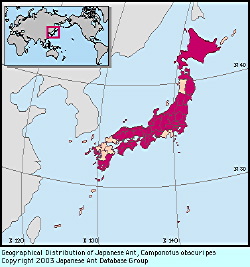
|
species
|
Camponotus obscuripes
|
 |
Japanese Name
|
Muneaka-oo-ari
|
Original Reference
|
|
Mayr, G. (1879) BeitrŠge zur Ameisen-Fauna Asiens. Verhandlungen der k.k. Zoologisch-Botanischen Gesellschaft in Wien 28 (1878): 645-686.
|
Synonym
|
|
Camponotus ligniperdus var. obscuripes Mayr (Mayr, 1879) ,
Camponotus obscuripes Mayr (Yasumatsu & Brown, 1957) ,
|
Description
|
|
Total length of workers around 7 - 12 mm. Body bicolored: mesosoma, petiole and basal portion of gaster red (sometimes yellowish brown to reddish brown); the remainder black. Hairs on 2nd gastral tergite short, those of the most posterior row not extending beyond posterior margin of the tergite.
|
Remarks
|
|
This species resembles C. hemichlaena, but is distinguished by its red pronotum (pronotum black in hemichlaena). Color variation is seen in some populations. For example, the body is almost black except for the petiole and adjacent areas which are reddish in Obihiro, Hokkaido; or completely black at Mt. Kuju, Kyushu. In these cases C. obscuripes is distinguished from other black Japanese Camponotus species, except C. yessensis, by the short pubescence on its 2nd gastral tergite. C. obscuripes is distributed from lowland to mountain areas. The high mountain populations tend to be darker in color than lowland ones. Nuptial flights occur from May to June in lowlands, and until August in the mountains. This species is found in forestsed areas. It nests in dead portions of standing trees or in rotting wood. The black woodpecker Dryocopus martius feeds preferentially on C. obscuripes in Hokkaido.
|
|

Distribution
|
|
Hokkaido, Honshu, Shikoku, Kyushu, Tsushima I., Yaku I.; Kurile Is, Sakhalin.
|
|
References
|
|
- BeitrŠge zur Ameisen-Fauna Asiens. Verhandlungen der k.k. Zoologisch-Botanischen Gesellschaft in Wien 28 (1878): 645-686.
- Yasumatsu, K. & W. L. Brown, Jr. (1957). A second look at the ants of the Camponotus herculeanus groups in Eastern Asia. . J. Fac. Agr. Kyushu Univ., 11, 45-51.
|
Editor
|
|
Original text by Mamoru Terayama, Masaaki Morisita and Keiichi Onoyama. English translation by Mamoru Terayama, edited by Robert W. Taylor.
|
|